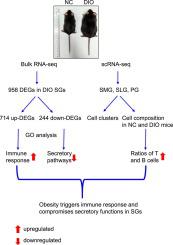Computational and Structural Biotechnology Journal ( IF 4.4 ) Pub Date : 2022-12-01 , DOI: 10.1016/j.csbj.2022.11.054 Heping Huang 1 , Ce Gao 1 , Shuai Wang 1 , Fen Wu 1 , Jinsong Wei 1 , Jinrong Peng 1

|
Obesity affects the function of multiple organs/tissues including the exocrine organ salivary glands. However, the effects of obesity on transcriptomes and cell compositions in the salivary glands have yet been studied by bulk RNA-sequencing and single-cell RNA-sequencing. Besides, the cell types in the sublingual gland, one of the three major salivary glands, have yet been characterized by the approach of single-cell RNA-sequencing. In this report, we find that the histological structure of the three major salivary glands are not obviously affected in the obese mice. Bulk RNA-sequencing analysis shows that the most prominent changes observed in the three major salivary glands of the obese mice are the mobilization of transcriptomes related to the immune response and down-regulation of genes related to the secretory function of the salivary glands. Based on single-cell RNA-sequencing analysis, we identify and annotate 17 cell clusters in the sublingual gland for the first time, and find that obesity alters the relative compositions of immune cells and secretory cells in the major glands of obese mice. Integrative analysis of the bulk RNA-sequencing and single-cell RNA-sequencing data confirms the activation of immune response genes and compromise of secretory function in the three major salivary glands of obese mice. Consequently, the secretion of extracellular matrix proteins is significantly reduced in the three major salivary glands of obese mice. These results provide new molecular insights into understanding the effect of obesity on salivary glands.
中文翻译:

大量 RNA-seq 和 scRNA-seq 分析揭示了肥胖小鼠主要唾液腺的免疫反应激活和分泌功能受损
肥胖会影响多个器官/组织的功能,包括外分泌器官唾液腺。然而,肥胖对唾液腺转录组和细胞组成的影响尚未通过批量 RNA 测序和单细胞 RNA 测序进行研究。此外,舌下腺(三大唾液腺之一)中的细胞类型尚未通过单细胞 RNA 测序方法进行表征。在这份报告中,我们发现肥胖小鼠的三大唾液腺的组织结构并未受到明显影响。大量 RNA 测序分析表明,在肥胖小鼠的三个主要唾液腺中观察到的最显着变化是与免疫反应相关的转录组的动员和与唾液腺分泌功能相关的基因的下调。基于单细胞 RNA 测序分析,我们首次鉴定并注释了舌下腺中的 17 个细胞簇,发现肥胖改变了肥胖小鼠主要腺体中免疫细胞和分泌细胞的相对组成。大量 RNA 测序和单细胞 RNA 测序数据的综合分析证实了肥胖小鼠三个主要唾液腺中免疫反应基因的激活和分泌功能的损害。因此,肥胖小鼠的三个主要唾液腺中细胞外基质蛋白的分泌显着减少。这些结果为了解肥胖对唾液腺的影响提供了新的分子见解。并发现肥胖改变了肥胖小鼠主要腺体中免疫细胞和分泌细胞的相对组成。大量 RNA 测序和单细胞 RNA 测序数据的综合分析证实了肥胖小鼠三个主要唾液腺中免疫反应基因的激活和分泌功能的损害。因此,肥胖小鼠的三个主要唾液腺中细胞外基质蛋白的分泌显着减少。这些结果为了解肥胖对唾液腺的影响提供了新的分子见解。并发现肥胖改变了肥胖小鼠主要腺体中免疫细胞和分泌细胞的相对组成。大量 RNA 测序和单细胞 RNA 测序数据的综合分析证实了肥胖小鼠三个主要唾液腺中免疫反应基因的激活和分泌功能的损害。因此,肥胖小鼠的三个主要唾液腺中细胞外基质蛋白的分泌显着减少。这些结果为了解肥胖对唾液腺的影响提供了新的分子见解。大量 RNA 测序和单细胞 RNA 测序数据的综合分析证实了肥胖小鼠三个主要唾液腺中免疫反应基因的激活和分泌功能的损害。因此,肥胖小鼠的三个主要唾液腺中细胞外基质蛋白的分泌显着减少。这些结果为了解肥胖对唾液腺的影响提供了新的分子见解。大量 RNA 测序和单细胞 RNA 测序数据的综合分析证实了肥胖小鼠三个主要唾液腺中免疫反应基因的激活和分泌功能的损害。因此,肥胖小鼠的三个主要唾液腺中细胞外基质蛋白的分泌显着减少。这些结果为了解肥胖对唾液腺的影响提供了新的分子见解。










































 京公网安备 11010802027423号
京公网安备 11010802027423号